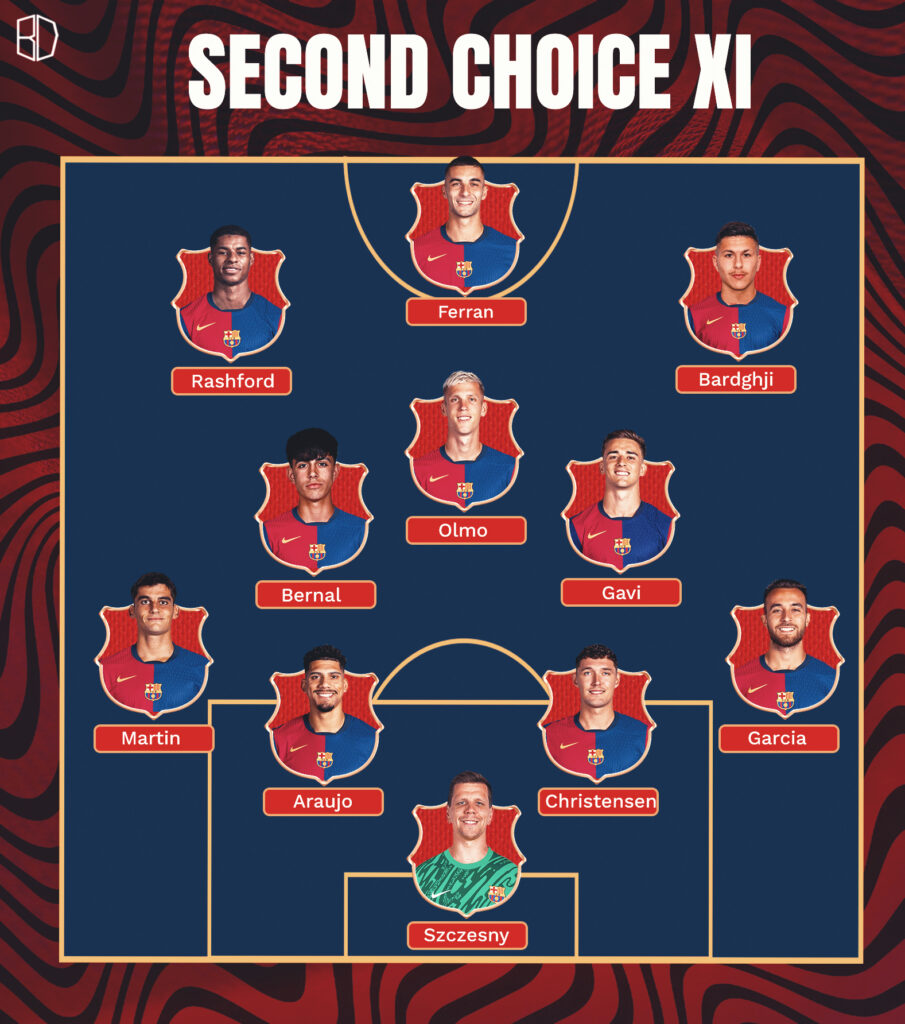Barcelona’s success last season largely boiled down to the quality of their starting lineup. With everyone fit and available, the Catalan giants managed to blow past every big European side they faced.
The moment starters suffered injuries, results went wayward, as was most notable in the Champions League tie against Inter when Alejandro Balde and Jules Kounde had to sit out. Lack of quality depth essentially cost the Blaugranes a treble.
To counter the relentless schedule and mitigate the physically taxing toll of Flick-ball, Barcelona are intent on bolstering their depth ahead of next season. With how the team is shaping up in the summer transfer window, both their starting and back-up teams look well-suited to compete for trophies on all fronts next season.
First choice XI: 4-2-1-3
Hansi Flick’s Barcelona have become synonymous with an attacking brand of football, and thus it barely bewilders that their front line boasts the heaviest hitters.
Nico Williams’ arrival at Barcelona appears to be taken for granted as the player has already accepted personal terms. All that is left is for Barcelona to pay the tricky winger’s release clause at Athletic Club.
Given the quality he possesses, Nico Williams is expected to be an immediate mainstay in the starting XI, featuring on the left flank. Partnering him in the front three would be the veteran striker Robert Lewandowski and Lamine Yamal on the right flank. Yamal has already achieved incredible heights with Nico as his wing partner at the Spanish national team, having won the Euro 2024 together.
With these names in the mix, Raphinha comes across as a notable omission. However, Flick is a master at accommodating various attacking profiles and the number 10 position is perfect for catering to the Brazilian output machine.
Afterall, Raphinha prefers drifting centrally and was by no means a classic winger even when he was deployed on the left flank last season. His deployment as an attacking midfielder will thus rid him of the responsibilities that come while operating on the touchline.
Behind Raphinha, Pedri and Frenkie de Jong are expected to continue bossing the midfield in the double pivot. The pair was instrumental in Barcelona’s second half of the campaign, showcasing a blend of ball-winning, tempo-setting, and creativity.
Finally, in the back-line, Barcelona are expected to continue banking on the experienced central defensive partnership of Inigo Martinez and Pau Cubarsi. The two were crucial in helping Barcelona master the offside trap, while also playing an enormous role in the build-up phase.
Flanking them on the right will be Jules Kounde, who has come leaps and bounds as a right-back, despite originally playing as a central defender. Meanwhile, Alejandro Balde is set to handle the reins on the left flank, who similarly showed massive progression last season under Flick.
Balde’s demanding role saw him take ownership of the entire left flank, but his life will be made a lot easier with a natural winger in Nico Williams — something Kounde already enjoyed with Lamine Yamal.
The biggest change in the back-line comes between the sticks. New signing Joan Garcia will be entrusted as Barcelona’s starting goalkeeper, dethroning Wojciech Szczesny and Ter Stegen in the pecking order. His exceptional campaign with Espanyol have already heightened expectations, especially since Barcelona suffered in the defensive department for years.
Second Choice XI: 4-2-1-3

Barcelona’s transfer targets give off the impression that Nico Williams will not be the club’s final season this summer. Given how fast the deal is progressing and the number of attacking players on their wishlist, a few more arrivals in the front line cannot be ruled out.
Among the names linked with the club are Marcus Rashford and Roony Bardghji, who could both prove to be excellent back-ups to Nico Williams and Lamine Yamal respectively.
Rashford’s instinctive ability to exploit spaces and score goals would render him a perfect fit in Flick’s system. Meanwhile, Bardghji possesses traits similar to Yamal, as he prefers cutting onto his left foot and weaving magic centrally. Completing the trident in the center would be Ferran Torres, who enjoyed his best campaign last season under Flick.
When it comes to the number 10 position, Barcelona are spoiled for choice. Not only do they possess last season’s marquee signing Dani Olmo, but also have Fermin Lopez in the pecking order, both of whom have proven themselves as shrewd final third threats. It will be intriguing to see who Flick prefers as the season progresses, yet Olmo’s experience is likely to give him an edge.
In the double pivot, options once again galore. Gavi is expected to gain more prominence with his ACL injury long behind him. His ability to control the tempo, play cross-field switches and serve as a relentless ball-winner mirrors many of Pedri’s qualities. Meanwhile, Marc Bernal will make his long-awaited return and fill the team’s void of a natural defensive midfielder. The youngster stood out tremendously in the few games he played last season, but an ACL injury brutally interrupted his progress.
Nonetheless, Bernal will be sure to have minutes next season as he is gradually eased back into the team. Aside from these two, Barcelona still have options like Eric Garcia and Marc Casado to chip in.
The back line features Gerard Martin on the left, Ronald Araujo and Andreas Christensen at center-back, and Eric Garcia on the right.
Martin has attracted significant interest from abroad, and if he departs, the club is likely to pursue a new left-back — with Alejandro Grimaldo high on the wishlist. One of Christensen or Araujo could also move on, though the pair have formed an excellent partnership, combining ball-playing ability with physicality when called upon.
Meanwhile, Eric Garcia has been a revelation at right-back, stepping up impressively during Kounde’s absence last season. Between the posts, Szczesny is expected to take charge in Joan Garcia’s absence, as Ter Stegen appears set for a summer exit.



